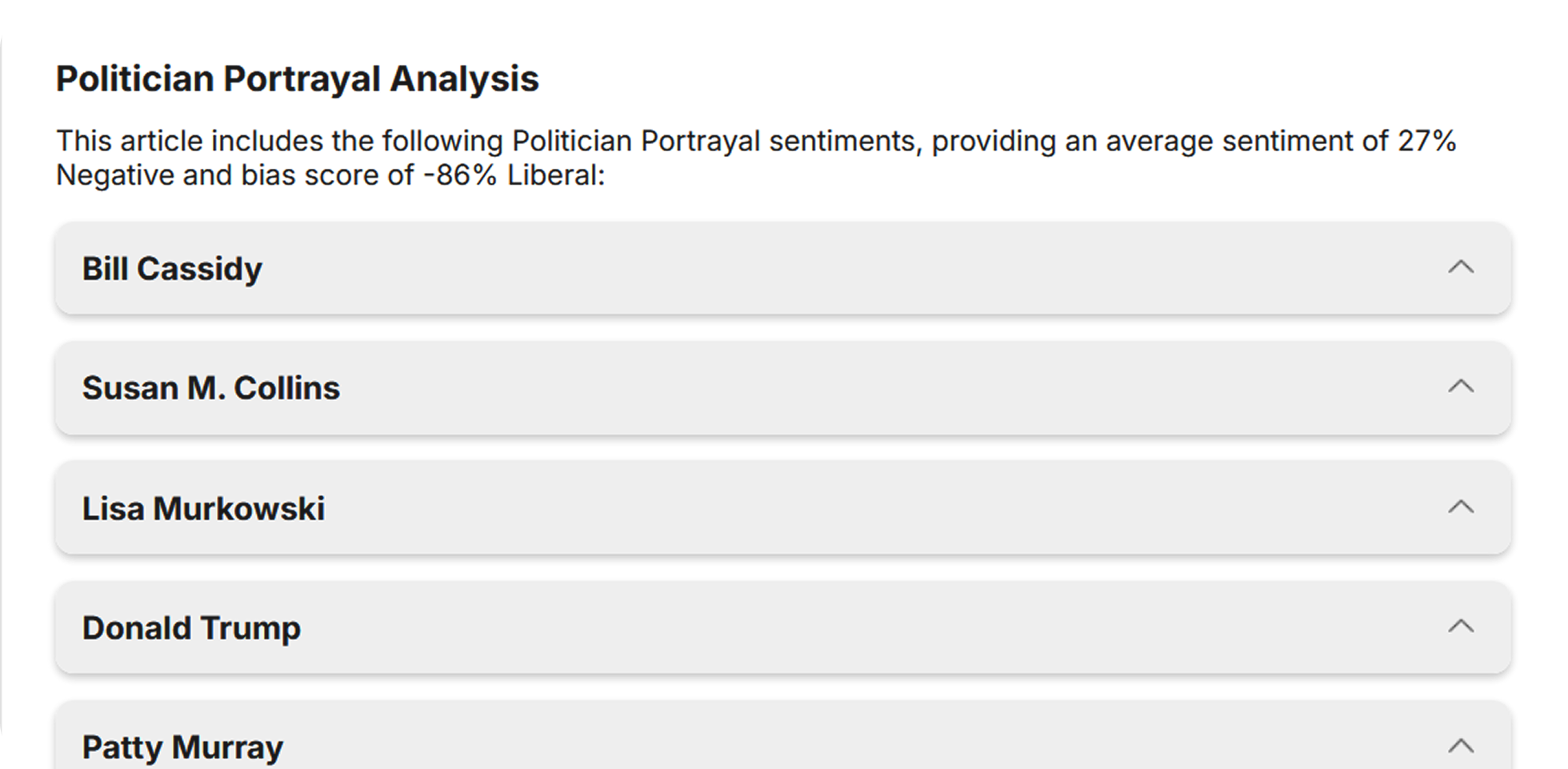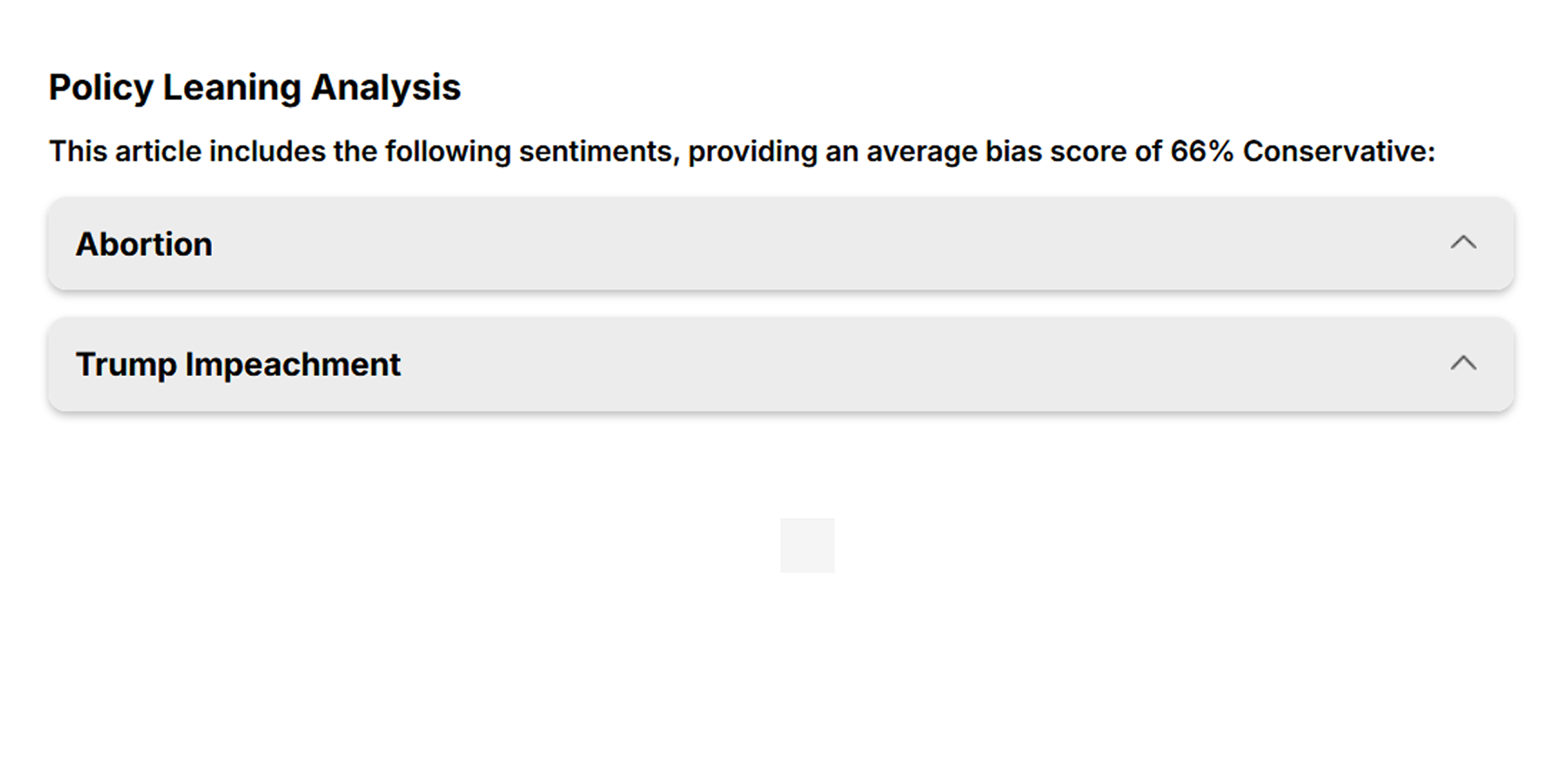AI-Powered Bias Detector
Bias Meter uses deep neural networks and natural language processing to identify political sentiments and predict biases in real-time news articles, generating a Computer Bias Score for each.

Stay informed about Bias in your media consumption
Biasly is a media bias rating agency that scans hundreds of articles daily to determine author bias and reliability issues within articles by using data science to analyze certain sentiments, policies, people, and terms found in the news. Below we will explore what our Bias Meter is and how it works.

Recognizing bias allows you to assess information critically rather than accepting it at face value.
Helps you spot emotionally charged or misleading narratives designed to sway your opinion.
Encourages you to seek multiple viewpoints rather than staying in an echo chamber.
Trains you to question sources, verify claims, and recognize logical fallacies.








Our bias meter, based on a a proprietary algorithm (U.S. patent no. 12135948), uses deep neural network and natural language processing components that are trained to identify political sentiments in news articles and predict biases in real-time articles that we show on our website and newsletter. Through this process, a Computer Bias Score is created for each article. Our site provides a list of bias scores and an overall average score for each news source including portrayals of politicians and policy leanings.
Bias Meter uses deep neural networks and natural language processing to identify political sentiments and predict biases in real-time news articles, generating a Computer Bias Score for each.
Our team of analysts rates articles from left, center, and right perspectives using Biasly’s proprietary methodology, providing a comparison mechanism to ensure and improve the accuracy of our computer-generated A.I. ratings.
At Biasly, we combine advanced algorithms with human oversight to ensure accuracy and fairness. Our AI analyzes language patterns, sources, and framing, but it doesn’t work alone—our team of expert analysts carefully reviews and verifies the results to maintain objectivity. This human-AI collaboration ensures that our ratings are not only data-driven but also thoroughly vetted for accuracy, making Biasly a trustworthy source for identifying media bias.
The Bias Meter empowers you to make smarter decisions by identifying and highlighting biases. Explore all its incredible features below!
Recognize bias as you read. Get a detailed breakdown of bias – even at the sentence level – so you can see exactly where it appears. See Bias Definitions
We evaluate the sources used in an article – you’ll see whether it relies on high-quality, balanced sources or if it pulls from biased ones. See Reliability Definitions
Stay informed about how certain politicians are portrayed so you know if they are being unfairly framed or misrepresented.

Understand how policies are framed to identify biases and ensure they aren’t being misrepresented or unfairly spun.

Our bias meter utilizes categories to classify news and other content on a percentage scale, where each category from “Very Left” to “Very Right” corresponds to specific ranges, enabling users to quickly understand the degree and direction of bias in news articles.
Aligns with mainstream Democratic Party ideologies, supporting significant reform while emphasizing pragmatic, incremental solutions. Firm but balanced tone aimed at coalition-building for progressive goals.
Balances perspectives from both the left and right. Focuses on moderate, pragmatic stances and often resists extreme positions. Prioritizes compromise and thorough consideration of differing viewpoints.
Advocates strongly for traditional conservatism emphasizing minimal government intervention, strict immigration enforcement, and free-market policies. Often uses passionate or uncompromising language to promote positions.
Advocates strongly for ambitious, immediate, and systemic change to address societal issues. Usually supports expansive government intervention and upends the status quo with progressive policies on nearly all topics.
Holds mostly left-leaning views with room for moderate or conservative positions on specific issues. Generally adopts a restrained approach, often favoring practical reforms over sweeping change.
Typically favors conservative principles while maintaining moderate, compassionate views on select issues. Advocates measured solutions with cautious attention to traditional values.
Advocates strongly for traditional conservatism emphasizing minimal government intervention, strict immigration enforcement, and free-market policies. Often uses passionate or uncompromising language to promote positions.
Our reliability score evaluates sources by categorizing them on a percentage scale, where each tier from “Limited” to “Excellent” corresponds to specific ranges, allowing users to quickly assess the trustworthiness and credibility of news sources.
Sources that consistently use few or no sources or quotes, with minimal diversity, uniqueness, or transparency. Quotes and links, if present, are often short, vague, or irrelevant. The lack of evidence or overly homogenous sourcing significantly undermines trust and overall credibility.
Sources that rely on a limited number of sources or quotes, with noticeable gaps in diversity, uniqueness, or length. Some quotes and links may appear superficial or repetitive and fail to add significant value. Reliability may come into question due to incomplete or weaker sourcing overall.
Sources that use an adequate number of sources and quotes, with some diversity and uniqueness, but occasionally lack depth or breadth. While most links and quotes are meaningful and moderately detailed, they may not always fully support claims. Still reliable, but with minor limitations in source diversity or completeness.
Sources that consistently use a high number of diverse and unique sources and quotes, reflecting thorough research and strong reliance on verified information. Quotes and links are substantial in length and detail, contributing meaningfully to the narrative. Demonstrates a balanced and comprehensive approach to sourcing, ensuring high levels of trustworthiness.
Simply paste it into Biasly’s News and Bias Checker! This powerful tool analyzes media bias and credibility, rating content from “Very Left” to “Very Right” and reliability from “Limited” to “Excellent.” It provides a clear, data-driven perspective on news sources, helping you make informed decisions and avoid misinformation.
Use Biasly surveys to understand your own biases.
Evaluates your political personality type, offering several categories such as Democratic Socialist, Devoted Democrat, Core Conservative, Conservative Constitutionalist, and more. This feature provides a deeper understanding of the your political leanings.
By learning your political personality type, you gain deeper insight into your values, beliefs, and decision-making tendencies. This self-awareness allows you to engage in more informed discussions by understanding where you stand on key issues and why. With a clearer grasp of your political leanings, you can make decisions that align with your core principles while remaining open to diverse perspectives, fostering more meaningful and productive conversations.
Knowing your personal bias helps you think more critically, make fairer decisions, and stay open to different perspectives. It allows you to recognize how your beliefs influence your opinions, helping you evaluate information more objectively and avoid being easily swayed by biased narratives. With this awareness, you can engage in more balanced discussions, challenge your assumptions, and make more informed choices.
Provides a bias rating based on a linear scale from -36 to +36. Negative numbers denote liberal bias, while positive ones signify conservative bias, spanning seven distinct categories from Extremely Liberal to Extremely Conservative.
Feel free to continue learning about how ratings are derived by viewing our Political Party Conservative and Liberal Stances page
Sign up for our Bias Education Courses to learn more about how to analyze news for yourself.
